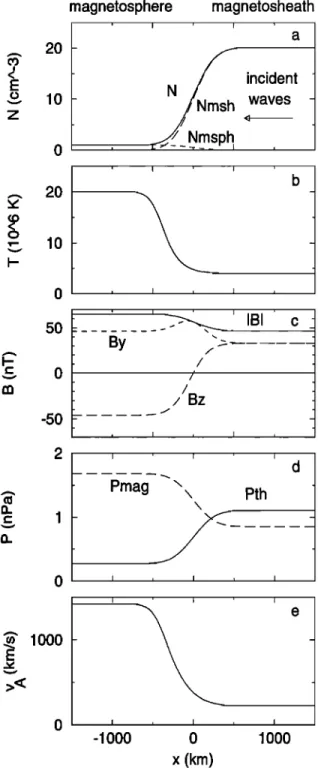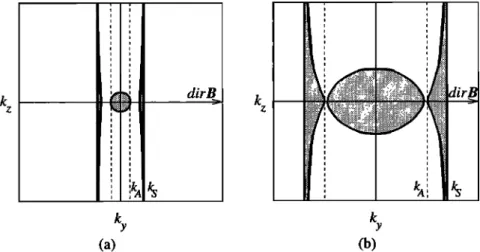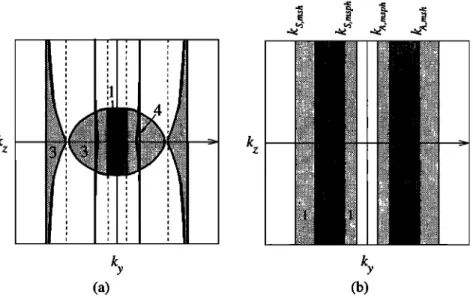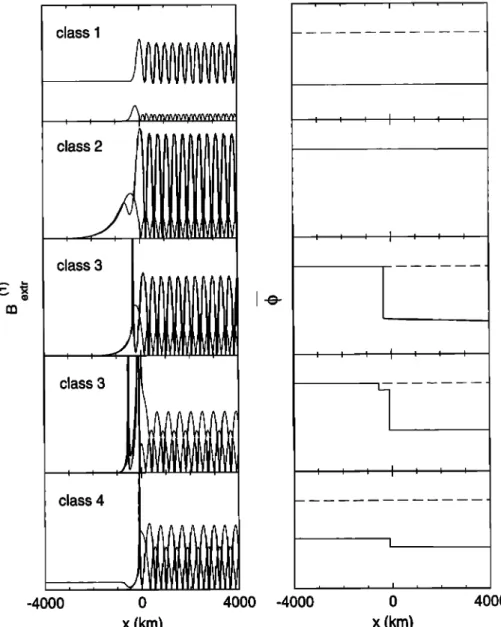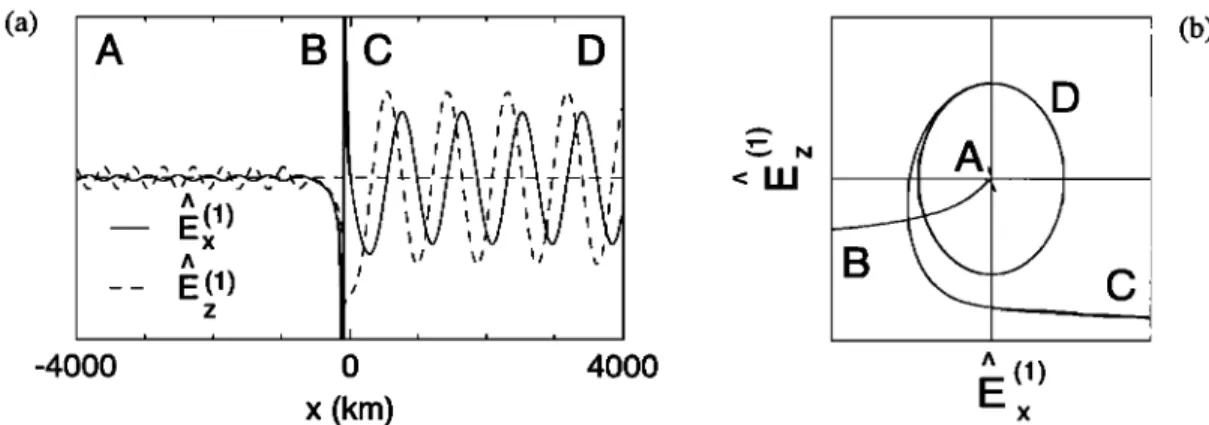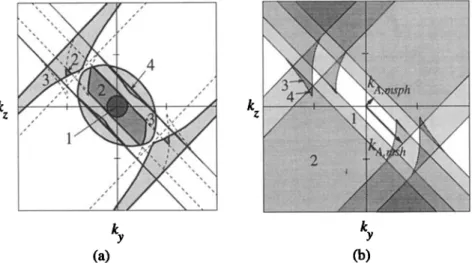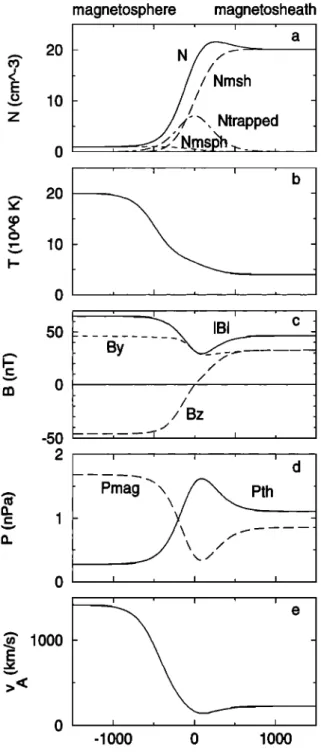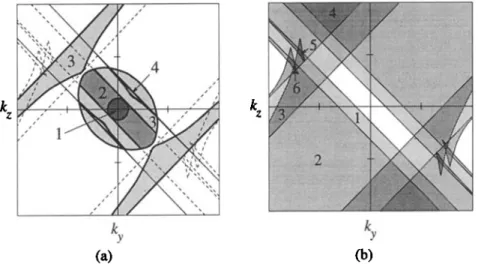HAL Id: hal-00408120
https://hal.archives-ouvertes.fr/hal-00408120
Submitted on 11 Jan 2021
HAL is a multi-disciplinary open access
archive for the deposit and dissemination of
sci-entific research documents, whether they are
pub-lished or not. The documents may come from
teaching and research institutions in France or
abroad, or from public or private research centers.
L’archive ouverte pluridisciplinaire HAL, est
destinée au dépôt et à la diffusion de documents
scientifiques de niveau recherche, publiés ou non,
émanant des établissements d’enseignement et de
recherche français ou étrangers, des laboratoires
publics ou privés.
Resonant amplification of MHD waves in realistic
subsolar magnetopause configurations
J. de Keyser, M. Roth, F. Reberac, L. Rezeau, G. Belmont
To cite this version:
J. de Keyser, M. Roth, F. Reberac, L. Rezeau, G. Belmont. Resonant amplification of MHD waves in
realistic subsolar magnetopause configurations. Journal of Geophysical Research, American
Geophys-ical Union, 1999, 104, pp.2399-2410. �10.1029/1998JA900060�. �hal-00408120�
JOURNAL OF GEOPHYSICAL RESEARCH, VOL. 104, NO. A2, PAGES 2399-2409, FEBRUARY 1, 1999
Resonant
amplification
of MHD waves
in realistic
subsolar
magnetopause
configurations
J. De Keyset
and M. Roth
Belgian Institute for Space Aeronomy, Brussels
F. Reberac, L. Rezeau, and G. Belmont
Centre d'l•tude des Environnements Terrestre et Plan6taires, V61izy, France
Abstract. Broadband
ULF fluctuations
are routinely
observed
throughout
the magne-
tosheath;
the fluctuation
level
peaks
at the magnetopause
and
becomes
very small
in the
magnetosphere.
The
present
paper
analyzes
the
propagation
of magnetosheath
waves
and
the
transport
of energy
at the subsolar
magnetopause
by means
of a linear
perturba-
tion
analysis
in the limit of the
MHD approximation.
We examine
realistic
equilibrium
magnetopause
configurations
with
a cold
and
dense
magnetosheath
and
a hot,
tenuous
magnetosphere,
possibly
including
a trapped
magnetopause
population.
The effects
of
magnetic
field
rotation
are
examined.
Resonant
amplification
of monochromatic
magne-
tosonic
waves
at the magnetopause
is found
to occur
under
various
conditions.
For a given
frequency,
several
field
lines
inside
the
magnetopause
layer
can
resonate
simultaneously.
1. Introduction
The dayside
magnetopause
interfaces
the shocked
solar
wind in the magnetosheath
(relatively
cold and dense)
and
the hot, tenuous magnetospheric plasma. The magnetopause
layer
carries
the diamagnetic
current
that
is associated
with
the magnetic
field rotation
from its magnetosheath
orien-
tation
(related
to the interplanetary
magnetic
field) to the
northward
magnetospheric
dipole
field. The overall
struc-
ture of the magnetospheric
boundary
can be understood
in
terms of equilibrium models, which assume the magneto-
pause
to be locally
in a tangential
or rotational
discontinu-
ity state
[e.g.,
Su and Sonnerup,
1968;
Lee and Kan, 1979;
Paschmann et al., 1979; De Keyser and Roth, 1997]. It is,
however,
generally
accepted
that time-dependent
phenom-
ena are important, especially for mass and energy transport across the interface. Such phenomena include flux trans-
fer events,
impulsive
penetration
of plasma,
and
the Kelvin-
Helmholtz instability. One of the open problems is the ques- tion of how the presence of ultralow-frequency (ULF) fluc-
tuations influences the transport of plasma and energy across
the magnetopause
[LaBelle
and Treumann,
1988].
ULF fluctuations are known to be present continuously in
the magnetosheath,
the magnetopause,
and
the low-latitude
boundary
layer;
the fluctuation
level
peaks
inside
the mag-
netopause
and drops
to a very low value
in the magneto-
sphere
[LaBelle
and Treurnann,
1988;
Rezeau
et al., 1989,
1993;
Song
et al., 1993]. The magnetosheath
fluctuations
can be associated with the bow shock geometry, and they Copyright 1999 by the American Geophysical Union.
Paper number 1998JA900060. 0148-0227/99/1998JA900060509.00
have been shown to have consequences on the internal mag- netospheric Pc3-Pc4 pulsations [Engebretson et al., 1991]. The strong fluctuation level at the magnetopause was first supposed to be due to a local instability of the boundary it-
self, but Belmont et al. [1995] suggested that it could also
be a consequence of the amplification of the magnetosheath
fluctuations that propagate downstream. This "resonant am-
plification" is a process invoked in other contexts as well, in particular for the generation of magnetospheric pulsations
[Southwood, 1974; Zhu and Kivelson, 1989] and for heat-
ing of the solar corona [see Hollweg, 1997, and references
therein]. It is worth noticing that MHD wave propagation
can give rise to two different kinds of resonances: (1) "field
line resonances", when the length of a magnetic field line is a
multiple of the parallel wavelength (like in "cavity modes"),
and (2)"mode resonances", when the wavelength in the di- rection of the inhomogeneity of the medium locally goes down to zero, which can occur for Alfv6n and slow modes. It
is this phenomenon that is supposed to give rise to the fluctu-
ation level enhancement at the magnetopause. The Belmont
et al. [1995] paper was limited by the hypothesis of a cold plasma and a unidirectional magnetic field, so that Alfv6n velocity variations are produced only by changes in plasma density. The present paper extends the analysis by consid- ering tangential discontinuity configurations that include fi-
nite temperature effects and that allow density, temperature,
magnetic field intensity and orientation to change across the
magnetopause.
The particular merit of this paper lies in the study of res-
onant amplification in realistic subsolar magnetopause con-
figurations, including magnetic shear effects. The validity of the present study remains, however, limited to the case of frequencies negligible with respect to the proton gyrofre-
2400 DE KEYSER ET AL.' RESONANT AMPLIFICATION AT THE MAGNETOPAUSE
quency, since it is performed under MHD conditions. As the broadband fluctuation spectrum extends beyond the proton gyrofrequency, it can explain only part of the fluctuation en- hancement. Nevertheless, it corroborates the scenario that
magnetosheath
ULF
fluctuations
can
propagate
downstream
and cause an increased fluctuation level at the magnetopause by resonant amplification.
2. Ideal MHD Perturbation Analysis
20
10
0
We take the subsolar magnetopause to be planar, with the 20
x axis being the Earth-Sun line (x < 0 corresponds to the •'
magnetosphere).
We will consider
small-amplitude
periodic
•P
perturbations
of an ideal
MHD magnetopause
equilibrium •o l 0
configuration,
which
represent
the
ULF fluctuations.
We
de-
!-
note the mass density by p, the bulk velocity by v, the mag- netic field by B, and the thermal pressure by p.
2.1. Equilibrium Configuration
The equilibrium configuration is assumed to be of the tan- gential discontinuity type without tangential plasma flow,
that
is, B•
(ø) - 0, v (ø) - 0. Let
the
magnetospheric
field
B•nsp
h -- B(ø)(-oo)
and
the
magnetospheric
and
mag-
netosheath mass densities and temperatures * Pmsph' Pmsh' *
T•sph,
T•nsh
be given.
The ion mass
is denoted
by m. We
then adopt the following equilibrium profiles:
p(O) ,
msph(X)
-- Pmsph•(X/O),
p(O)msh(X)
-- Pmsh•(--x/D),
,•(o) •(o)
p(O)
(X) -- t•msph
(X)
q-
t•msh
(X),
T (ø)
(x) r,•, (o)
-- [l msphPmsph
(X) q- -•mshHmsh
,v* ,,(o)
(x)l/p(O)(x)
,
p(O)
th (X) -- kBp(O) (X)/m,
T(O)
1
where
the transition
function
6(x/D) - • erfc
(x/D) al-
lows a smooth density variation with half-width D (where
erfc denotes the complementary error function); this choice is inspired by analytic tangential discontinuity models [Roth et al., 1996]. We prescribe a smooth rotation of the magnetic field through an angle 0* in the same region:
0
0*
0 (ø)
(x) - •- erf
(x/D)
(with erf denoting the error function). We adopt the nu-
merical
values
P•nsph/m
-- 1 cm-3,
P•nsh/m
-- 20 cm-3,
Tr•sp
h -- 20 x 106
K, T•ash
-- 4 X 106
K, Bmsph
-- 65 nT,
and a magnetopause half-thickness D - 300 km [Berchem and Russell, 1982]. The magnetic field profile is then de- termined from the pressure balance condition, with Bmsh -- 46 nT. Different rotation angles 0* will be considered. This equilibrium configuration, shown in Figure 1, is more real- istic than the cold plasma, zero magnetic shear case studied
by Belmont et al. [1995]. We find Alfven speeds VA,msh --
225 km s-1 < VA,msph
-- 1420
km s-1 and
sound
speeds
Cs,msh
-- 235 km s-1 < Cs,msp
h __ 525 km s-l, which
means
fim•ph
-- 0.13 and
fimsh 1.09 (fi -- 2 2
- Cs/VA).magnetosphere magnetosheath • I incident waves
,
, I I By 1000 0 -50 ... 2 b C . / / Bz Pmag Pth I I -1000 0 1000 x (km)Figure 1. Subsolar magnetopause equilibrium adopted in this paper (for 90 ø magnetic shear). The x axis is the Earth-Sun line; the y, z plane is parallel to the locally planar magnetopause. The magnetosphere is to the left, the magne- tosheath to the right of the magnetopause. The y axis is the bisector of the magnetospheric and magnetosheath magnetic
field
directions
n(0) and
"-'msph •"msh'
R(o)
(a) Magnetosheath,
mag-
netospheric, and total number density; (b) temperature; (c) magnetic field; (d) magnetic and thermal pressure; and (e) Alfven velocity.
2.2. First-Order Perturbation
Consider perturbed quantifies
DE KEYSER ET AL.: RESONANT AMPLIFICATION AT THE MAGNETOPAUSE 2401
where r = [x, y, z] is the position vector of a plasma ele-
ment, w = 2Try is the angular frequency (v = 0.5 Hz is
used
in the examples),
and kt = [0, kv, kz] is the tangential
wave vector. The linearization of the ideal MHD equations
is discussed in the Appendix. The normal plasma displace-
ment •x (x) and the total pressure perturbation r(x) are both
continuous,
even
across
MHD discontinuities.
The perturb^a-
tion can
be computed
once
the quantity
g = r/•x = '•/•
is known; the linearized MHD equation for g is [Belmont et
al., 1995] '
Og
_ iKx
(G
2 _ g2),
(1)
Ox G where 03 2p(0)f•2
G = iK• 'a2 -
w2 _ (k.VA)
2.
Here
VA -- B (0)/(•0/9(0))
1/2 is the
local
Alfv6n
speed.
We
have solved (1) by complex numerical integration. We im- pose as boundary condition that there must be a linearly po- larized, earthward propagating wave on the magnetospheric
side (g(-c•) = 4-G as will be shown later; the sign is cho-
sen such that the amplitude of the wave remains bounded). In the Appendix we show how the perturbed magnetic field, velocity, density, pressure, and electric field are computed, as well as the time-averaged energy flux.
3. Magnetosonic Wave Propagation
We first study the propagation of monochromatic mag- netosonic ideal MHD waves in the uniform magnetosheath and magnetospheric regions. The only MHD waves whose propagation velocity can have a nonvanishing component along the Sun-Earth line are the fast and slow magnetosonic modes. Uniform plasma parameters and a constant magnetic
field imply constant VA, Cs, •, Kx, and G. It can be shown that bounded solutions for •x(x) and r(x) exist only when
K•
2 _> 0. The simplest
solution
then
is a linearly
polarized
wave with k• - 4-K•, corresponding to a magnetosonic
wave propagating to the left or to the right, in which case g is constant. Equation (1) then implies that g - 4-G, that is, g is purely imaginary: •x and r are 90 ø out of phase.
Let kA -- W/VA.
The
angle
between
let and
B © is de-
noted
by 0. The
propagation
condition
Kz
2 _>
0 is equivalent
to1
kt
2/k•
_<
1 +/3(1
- (kt
2/k•)
cos
2
0)'
(2)
For fi = 0 the denominator never becomes zero; the wavepropagates if kt < kA, that is, if the propagation domain in
the wave vector plane is circular. When fi > 0, the denomi-
nator
on the
right-hand
side
is zero
when -
cos
01 -
ks - wx/1 +fi/cs, which corresponds to a resonance of the
slow
mode.
Consider
the
case
Ikll
I < ks: the
right-hand
side
in (2) then is positive, and the condition is
ticos20
•
-(l+fi) •
+1_>0.
(3) The zeros of this biquadratic expression arek•:
- k,•
(1
+/3)
4-
v/(1
2/3
cos
+ fl)2
2 0
_ 4/3
cos
2
0
o (4)
For each angle 0 there exist two zeros k+ (with k_ < k+; we allow only positive wave numbers). The case k_ - k+occurs for fi - 1 and I cos 01 - 1. It is easy to check that
magnetosonic waves can propagate when 0 _< kt <_ k_ or
k+ _< kt < ks / cos 0 (note that always k+ < ks / cos 0). A
similar analysis shows that there are only evanescent solu-
tions
when
[kll
I >/cs. The biquadratic
equation
is degener-
ate for 0 - 4-7r/2; the propagation condition then becomes 0 _< kt _< kA/x/l+/3. For0 -- 0andfi > 1 the val-
ues k_ and k+ are kA/x/-• and kA; when/3 < 1, one has
k
k k
(a) (b)
Figure
2. Projection
of the dispersion
relation
on the ku, kz plane
(tangential
to the magnetopause)
showing
the magnetosonic
wave
propagation
domain
(shaded
regions)
and the Alfv6n
and slow-wave
resonance
conditions
(kll - /CA
and
kll - /cs)
(a) in the
magnetosphere
(fi - 0.13)
and
(b) in the
magnetosheath
(fi - 1.09).
Both
figures
are
made
on
the
same
scale.
The
y axis
points
along
B © .
2402 DE KEYSER ET AL.' RESONANT AMPLIFICATION AT THE MAGNETOPAUSE
k k
(a) (b)
Figure 3. Projection of the dispersion relation on the kv, kz plane for the zero magnetic shear magne-
topause.
The
y axis
points
along
B © . (a) Superposition
of the
dispersion
relations
for magnetosphere
and
magnetosheath (see Figures 2a and 2b). There are four distinct solution classes (the regions where each of these classes occurs are shaded differently): class 1, partial reflection and partial transmission; class 2, complete reflection; class 3, partial reflection and partial absorption; and class 4, partial reflection, partial transmission, and partial absorption. (b) Number of resonance points; light shading indicates a single resonance, darker shading indicates simultaneous resonance at two points inside the magnetopause.
k_ = kA and
k+ = kA/X•. Figure
2 shows
the wave
vec-
tor diagram, that is, the dispersion relation projected onto
the kv, kz plane, for the magnetosphere and magnetosheath
parameters chosen earlier. The shaded regions correspond to wave vectors for which magnetosonic waves of a given fre- quency can propagate (the diagram scales with kA or, equiv- alently, w). The magnetic field vector is oriented along the
ku axis. For the magnetospheric case (Figure 2a)/• is small,
so that k_ << k+. In the magnetosheath (Figure 2b), how- ever,/• is close to unity, and k_ and k+ nearly coincide for
0 = Oor•r.
4. Resonant Amplification
The nature of the solution of (1) depends on the bound-
edness
of the
coefficient
iKx/G - -K•2/p(ø)•
2 inside
the
magnetopause. If it is unbounded at a certain point inside the
magnetopause,
(7 - 0 at such
a singularity,
that is, Ft
2 - 0
or K•
2 is infinite:
w-
I/clllvA,
(5)
co = . (6)
These two conditions correspond to the Alfv6n and slow-
mode waves, respectively. At each point where one of both conditions is satisfied, the x variations characterizing the in- volved mode occur on a scale that becomes infinitely short, leading to the divergence for some components (unbound-
edness of IOg/Ozl). This phenomenon is called "resonant
amplification". Equation (1) can then no longer be solved.
The nature of this singularity is discussed by Southwood [1974]. In order to avoid the occurrence of a true singu- larity (which is due to the oversimplicity of the model) in the numerical computations, we have used the technique ad- vocated by Belmont et al. [1995]: we add a small complex component to kt. Essentially, this means that we use per- turbations that have a low-frequency modulation tangential to the magnetopause surface. Southwood [1974] and Holl- weg [1997] avoid the singularity by explicitly including an energy absorption process in the model.
4.1. No Magnetic Shear
We first consider the situation of a unidirectional mag-
netic
field
B(ø) parallel
to the
•/axis.
At the
magnetopause,
it is generally found that kA,msph < kA,msh. Therefore a
magnetosonic wave of magnetosheath origin can propagate earthward toward the magnetopause, but it is not necessarily transmitted across the magnetopause since it may not be able to propagate into the magnetosphere. For a given vector either zero or one resonant amplification point can be found from (5), at least if kA (or VA) varies monotonously across the magnetopause. If it exists, the resonant point z* satisfies
kA
(x*) = kll. A similar
result
can be obtained
from
(6).
Therefore resonant amplification occurs when (5) or (6) are fulfilled, which implies
kA,msph
< Iklll < kA,msh
or
kS,msph
< lklll < kS,msh.
When
both
intervals
for I kll
I overlap,
there
can
be simultane-
DE KEYSER ET AL.: RESONANT AMPLIFICATION AT THE MAGNETOPAUSE 2403 class 1 class 3 class 3 class 4 i i i I i i i -4000 0 4000 -4000 0
x (km)
x (km)
4OOOFigure 4. Representative solutions for the zero magnetic shear magnetopause in the warm plasma case.
The
figures
plot
the
maximum
and
minimum
values
of the
modulus
of (left)
B (1) (in arbitrary
units)
and
(right)
the
time-averaged
energy
flux ½ (in arbitrary
units;
zero
flux corresponds
to the dashed
horizontal
line) as a function of the distance to the center of the magnetopause (in km). The magnetosphere is to the left and the magnetosheath is to the right of the magnetopause. Class 1' a nonvanishing perturbation intensity in the magnetosphere indicates transmission, while the energy flux remains constant as the inci-
dent flux equals the transmitted flux plus the reflected one. In the reference frame adopted here, a negative
flux ½ < 0 indicates energy transfer from the magnetosheath to the magnetosphere. Class 2: the wave does not penetrate into the magnetosphere and is completely reflected, resulting in a net zero energy flux. Class 3: similar to class 2 but now resonant amplification (infinite wave amplitude) occurs at one or two
points inside the magnetopause; resonant absorption implies a jump in the energy flux profile. Class 4:
reflection, transmission, and resonant amplification occur simultaneously; again, ½ is discontinuous at the resonant points.
In the cold plasma case the second condition is never met; there is at most one resonant point [Belmont et al., 1995].
Figure 3a shows the wave vector diagram. The solid lines demarcate the propagation domains of magnetosonic waves in the magnetosheath and the magnetosphere, respectively. The dashed lines demarcate the resonant amplification re- gions. Belmont et al. [1995, Figure 2] identified three so- lution classes in the cold plasma limit: class 1, the mag-
netosheath wave propagates through the magnetopause and continues earthward in the magnetosphere; class 2, the mag- netosheath wave is not transmitted; and class 3, the magne- tosheath wave is not transmitted, but resonant amplification does occur. In the warm plasma case there is an additional class: class 4, waves that are both transmitted and resonantly amplified. Figure 3b counts the number of resonance points in the wave vector plane. Some representative solutions of
2404 DE KEYSER ET AL.' RESONANT AMPLIFICATION AT THE MAGNETOPAUSE (a) -4000
D
J 4000G
Ax (km)
E
xFigure 5. Electric field polarization for the class 4 solution of Figure 4. (a) Plot of the electric field
components/•(•)
and/•z
(•) (in
arbitrary
units)
along
the
Earth-Sun
line
(/•(•)
- 0 as
B © parallel
to
(b)/•(•),/•z
(•) hodogram,
showing
the
linear
polarization
in
the
magnetosphere
(labeled
A) and
the
elliptic
polarization
in the
magnetosheath
(labeled
D), while
•(•) is unbounded
at the
resonance
point
(labels
B
and C immediately left and right of the resonance point, respectively).each class are shown in Figure 4. The figure shows for each
solution
the values
between
which
the magnetic
field per-
turbation varies at each position along the Earth-Sun line, as well as the corresponding energy flux profile. Resonant points are easily identified since the perturbation becomes unbounded there (classes 3 and 4). Waves penetrating the
magnetosphere
are characterized
by a nonvanishing
ampli-
tude in the magnetosphere (classes 1 and 4). As shown in the
Appendix,
the time-averaged
energy
flux • along
the
Earth-
Sun line must be constant for ideal MHD and real kt, ex- cept at singular points. A small departure from these ideal
conditions
implies
energy
flux changes
only
at points
where
the gradients
are large,
that
is, at the singular
points.
In the
present calculation, no dissipative terms are included, but an
imaginary
part has
been
added
to the tangential
wave
vector
kt. This
means
that
the energy
flux is not
actually
absorbed,
but only diverted into the tangential plane. Class 1 solutions,
which
have
no singular
points,
are
therefore
characterized
by
a constant earthward flux q• < 0; the energy flux associated with the magnetospheric wave equals the flux of the incident
minus the reflected magnetosheath waves. In class 2 solu-
tions,
all the incident
flux is reflected
back,
so that • - 0.
Class 3 and 4 solutions possess singular points (the resonant
points) where q• can be discontinuous. We have checked that
the jump values
are independent
of the size
of the imagi-
nary
part of the wave
vector,
as long
as the imaginary
part
is small
enough
so that the resonance
peak
is narrower
than
the
magnetopause
gradient
scale.
The numerical
integration
step should of course be even smaller so as to resolve the
resonance peak.
Figure
5 plots
the
electric
field
perturbation
•7
(•) for
the
class 4 solution shown in Figure 4. For a unidirectionalB © along
•t, one
has
•u
(•) - 0. Earthward
of the
mag-
netopause
(labeled
A in the figure)
the electric
field polar-
ization
is linear
(by choice
of boundary
condition).
At the
resonance
point
(B, C), /•(•) becomes
unbounded.
In the
magnetosheath
(D) the electric
field is the superposition
of
the fields
associated
with the incident
and reflected
waves,
resulting in an elliptical polarization. This is consistent with
the result
of Southwood
[1974] that the polarization
sense
can
change
only at extrema
of the electric
field
magnitude,
the only
extremum
here
being
at the resonance
point.
Note
that this result
would
imply subsequent
polarization
sense
changes
in the class
3 solutions
with multiple
resonance
points.
However,
with
the
magnetopause
thickness
adopted
here,
the
distance
between
the
resonance
points
spans
only
part of a wavelength, so that the polarization sense cannot
clearly be established there.
4.2. Nonzero Magnetic Shear
The presence
of magnetic
field rotation
complicates
the
resonant amplification conditions. In the discussion below
we choose
the
g/axis
to be the
bisector
of B © and
msphB ©
msh 'and we take kA,msph
< kA,msh
and k$,msph
< kS,rash
(the situation at the magnetopause). Figure 6 shows the
hodogram
of kA -- kAB(ø)/B
(ø) for magnetopause
con-
figurations
with or without
magnetic
shear. Figure
6a is
made
for a unidirectional
magnetic
field
along
g/;
the
kA
hodogram then is a straight line. As discussed earlier, and as illustrated graphically, there can be at most one resonant point when kA(:C) is monotonous. A similar construction
can
be made
using
the
hodogram
for ks - ksB(ø)/B
©,
possibly
leading
to a second
resonant
point.
Figure
6b shows
the kA hodogram
for the case
of nonzero
magnetic
shear,
with monotonous
kA (a:) and
monotonous
magnetic
field
ro-
tation over 90 ø . The graphical construction shows that reso-
nant
amplification
according
to (5) can
occur
simultaneously
at two different
points
inside
the magnetopause
for a given
wave vector. Resonance is obtained at those points where
kll - k A(Z), that
is, at those
points
where
the
projection
of
k on
the
direction
of B (ø)
(a:)
coincides
with
kA
(:c).
The wave
vector
diagram
is given
in Figure
7a; it is ob-
tained
by superposing
the propagation
domains
for magne-
DE KEYSER ET AL.: RESONANT AMPLIFICATION AT THE MAGNETOPAUSE 2405 k k '% k k
z
dirB•,nse•
,•...dtrB•
I ',;"•
•'<'•'d.
trB2
dirBms
•
(a) (b)Figure
6. Hodogram
of kA
(z) in the
ku,
kz plane.
The
y axis
is the
bisector
of n(o) and
"" rnsph•(o)
"" msh' or, equivalently, of kA,msph and kA,msh. The two circles indicate the projection of the wave number in themagnetosheath (large circle) and in the magnetosphere (small circle). The resonant condition is fulfilled
at points where the projection of k on the direction of B equals kA (z). (a) Zero magnetic shear: the hodogram is a straight line segment, and at most one resonance point exists if kA (z) is monotonous. (b)
High
magnetic
shear:
for a given
k, resonance
with [kll
[ = kA
(z) can
occur
at several
points
inside
the
magnetopause simultaneously (two resonances in this case).
tosheath and magnetospheric magnetosonic waves (rotated as determined by the 90 ø magnetic shear) and the reso- nance conditions. Figure 7b counts the number of reso- nance points. No resonant amplification can occur when
kt < kA,msph (the circular region with class 1 solutions in
the center
of Figure
7a). When
kll,msp
h > kA,msph
with
kt not much larger than kA,msph, resonance occurs near the
magnetospheric edge of the magnetopause. This is shown in Figure 7b by two straight lines running from the upper left to the lower right, which are tangent to a circle (not drawn) with
radius
kA,msph
and
perpendicular
to kA,msph,
and
which
de-
marcate the region where resonance occurs. Resonance oc- curs near the magnetosheath edge of the magnetopause when
kll,msh
< kA,msh
with kt not much
smaller
than kA,msh,
which
translates
into two demarcation
lines running
from
the lower left to the upper
right, which are tangent
to a
circle
(not drawn)
with radius
kA,msh
and perpendicular
to
kA,msh.
Again, a similar
reasoning
can be applied
to the
ks hodogram
(resonance
condition
(6)), leading
to two ad-
ditional
pairs of straight
lines that demarcate
regions
with
additional resonance points. 4.3. Trapped Populations
We have shown that the occurrence of resonance is closely related to the k A and ks hodograms. However, the unper-
turbed magnetopause configuration used above was to some
extent arbitrary. It is known that, at least for large magnetic shear configurations, the magnetic field strength often is de-
k
k k
(a) (b)
Figure 7. Propagation of waves at the magnetopause for 90 ø magnetic shear. The y axis is the bisector of
B(O) and
msphn(o) The
"-•msh'magnetosonic
propagation
domains
of Figure
2 are
rotated
over
+45
ø and 45
--ø.
2406 DE KEYSER ET AL.: RESONANT AMPLIFICATION AT THE MAGNETOPAUSE 20 10 20 10 50 -50 2 lOOO magnetosphere magnetosheath • I I ß / / Nmsh ß , Ntrapped
,
....
b By / / / Bz I IPmag
• •\••.•7th
-1000 0 1000Figure 8. Magnetopause equilibrium when a trapped pop- ulation is present (90 ø magnetic shear). (a) Magnetosheath,
magnetospheric, trapped population, and total number den-
sity; (b) temperature; (c) magnetic field; (d) magnetic and
thermal pressure; and (e) Alfv6n velocity reaching a local minimum inside the magnetopause.
pressed inside the magnetopause layer because of the pres- ence of "trapped" particles that carry the diamagnetic cur- rent inside the magnetopause layer [Song et al., 1993; Hu-
bert et aL, 1998]; kA (x) and ks(x) will then no longer be
monotonous. It is therefore more realistic to add a plasma component with density profile [Harris, 1961 ]
p(O) ,
trapped(X)
-- /9trapped/cosh•(x/D)
and
temperature
T•;appe
d = (T•asphT•ash)
1/2,
the
geomet-
ric mean of the magnetosheath and magnetospheric temper- atures. The structure of such a transition is illustrated by
Figure
8 for the
case
of a 90
ø rotation,
with
p•*rapped/m
--
7 cm
-3. Since
kA(x) is no longer
monotonous,
resonant
amplification can occur at more points (if 0(x) also is not
monotonous, even more resonant points can exist). The di- agrams showing the solution classes and the number of res- onance points are given in Figure 9. Since including the trapped population decreases the Alfv6n velocity, more res- onant points exist near the center of the transition, with res- onance for larger wave vectors; the corresponding waves are not always able to propagate through the magnetosheath. It is, however, possible that ULF perturbations become trapped in such Alfv6n velocity valleys [Zhu and Kivelson, 1989].
5. Discussion and Conclusions
The purpose of the present paper was to re-examine the mechanism of resonant amplification of MHD waves at the magnetopause discussed by Belmont et al. [ 1995] in a more realistic subsolar magnetopause setting that includes the ef- fects of plasma pressure, magnetic field rotation, and trapped populations. We have computed the spatial profiles of all possible types of wave solutions, their polarization, and the corresponding energy flux profiles.
The inclusion of thermal pressure effects leads to the ap- parition of slow-mode resonances in addition to Alfv6n wave resonances. Indeed, there exist two types of mode conver- sion: fast-mode waves can couple to Alfv6n or slow-mode waves. A first implication is that there exists a fourth wave solution class in addition to those distinguished by Belmont et al. [1995]. The four classes include waves propagating through the magnetopause, with or without resonant am- plification, and evanescent waves with or without resonant amplification. A second implication is that for a given fre- quency, resonant amplification can occur at several points inside the magnetopause simultaneously. Even more reso- nance points appear when there is a significant rotation of the magnetic field across the magnetopause and when there are diamagnetic effects due to the presence of trapped parti-
cles that carry the magnetopause current.
The results reported here are based on a "closed" magne- tosphere model. Indeed, we have adopted a tangential dis- continuity magnetopause structure. It can also be shown (see the Appendix) that in the present model the mass flux across the magnetopause is zero (at least up to the second order). Nevertheless, our findings illustrate that there can be a sig- nificant transport of wave energy across a closed magneto- sphere boundary. The calculations demonstrate that there are different possibilities for wave energy transport.
A first possibility is that the energy carried by an earth- ward propagating magnetosheath wave is transmitted across the magnetopause without appreciable attenuation if its fre- quency is below the magnetospheric Alfv6n and slow-mode resonance frequencies. Conversely, for a given frequency, transmission occurs when the tangential wave vector is be- low the limit set by the magnetospheric Alfv6n and slow-
DE KEYSER ET AL.: RESONANT AMPLIFICATION AT THE MAGNETOPAUSE 2407
k
k k
(a) (b)
Figure 9. Propagation of waves at the magnetopause for 90 ø magnetic shear when a trapped population
is present.
The
•t axis
is the
bisector
of n(o) and
•"rnsphn(o) The
•"rnsh'magnetosonic
propagation
domains
of
Figure
2 are rotated
over
+45 ø and -45 ø. (a) Solution
classes.
(b) Number
of resonance
points.
mode speeds; the incident wavefronts then are nearly planar. An example of such waves are those in the milliHertz fre- quency range discussed by Southwood [ 1974]: these waves propagate across the magnetopause, but as the magnetic field and the Alfvtn and slow-mode velocities increase upon ap- proaching Earth, mode conversion eventually takes place on drift shells in the inner magnetosphere. This mechanism is believed to be the source of micropulsations. The wave en- ergy is deposited inside the magnetosphere.
Second, if resonance occurs, mode conversion of the inci-
dent waves (which have a small frequency modulation in our model) results in diverting the normally incident energy flux into the tangential directions at the sites of resonance: the energy is carried away by surface waves, traveling parallel to the magnetic field. If we would have introduced a dis- sipation mechanism in our model, the effect would be that energy is fed to the plasma inside the magnetopause current layer. The mode conversion mechanism then could be the source of heating effects at the magnetopause. The present paper shows that mode conversion generally does not oc- cur at a single point but that it can occur at many places inside the magnetopause layer simultaneously. This is even
more so when the incident waves are not monochromatic.
Wave energy deposition is therefore expected to take place throughout the entire magnetopause current layer.
Last, an incident wave can be reflected so that it delivers
no energy to the magnetosphere.
The calculations presented here illustrate that all combi-
nations of these three situations can occur. We find that
most of the fast magnetosonic waves that propagate through the magnetosheath give rise to resonant amplification at the magnetopause, unless their frequency is sufficiently low so that they can penetrate into the inner magnetosphere, where mode conversion may still be their ultimate fate. Resonant amplification at the magnetopause appears to be the rule, rather than the exception. These findings seem to support
the following picture: incident magnetosheath ULF waves (possibly generated near the bow shock) lead to enhanced fluctuation amplitudes at the magnetopause because of res- onant amplification there, while the fluctuation level drops to relatively low values in the magnetosphere as a large frac- tion of the waves cannot propagate across the magnetopause. This is in qualitative agreement with observations. In terms of energy flux, this implies that a significant fraction of the incident flux is reflected, a significant fraction is absorbed at the magnetopause, and only a small fraction is able to reach the inner magnetosphere.
It is outside the scope of this paper to estimate the total wave energy flux deposited into the magnetopause current layer from a quantitative point of view because of the many simplifications that have been made in the analysis. Indeed, we have left the dissipation mechanism unspecified. The model is only one-dimensional. Also, the ideal MHD single- fluid hypothesis limits the generality of the results. The electron response to the ULF field is expected to be rather unimportant because of the low frequencies considered, jus- tifying a single-fluid approach. Finite gyroradius effects and the accompanying charge separation electric fields, however, might be of some importance, as the magnetopause is often only a few ion gyroradii thick [Berchem and Russell, 1982]. First results in this field have been published by Johnson and Cheng [ 1997]. The present paper dealt with monochromatic waves with a frequency that is negligible with respect to the proton gyrofrequency (MHD conditions). In order to take into account the broadband spectrum observed in the magne-
tosheath, ion inertia effects should be included in the model.
This might have so•ne consequences on the behavior of the waves, since waves propagating in a homogeneous medium are modified by ion inertia effects [Belmont and Rezeau, 1987]. A linear perturbation analysis is useful for evaluating the effects of ULF fluctuations in the 0.1-1 Hz range on the subsolar magnetopause in the quasi-steady regime, at least
2408 DE KEYSER ET AL.: RESONANT AMPLIFICATION AT THE MAGNETOPAUSE in a first approximation, but the observed fluctuation levels
suggest that nonlinear effects can be important [Rezeau et al., 1989].
Appendix'
Linearized
MHD Equations
The linearization
of the ideal MHD equations
has been
discussed
in the literature,
for example,
by Walker
[1981].
This appendix
describes
the linearization
procedure
in the
context of monochromatic waves at the one-dimensional subsolar magnetopause, and adds a discussion of the com- putation of the energy flux.
Let x be the
outward
normal
to the
(planar)
magnetopause.
Denoting
the mass
density
by p, the bulk
velocity
by v, the
magnetic
and
electric
fields
by B and
E, the thermal
pres-
sure
by p, the
energy
by œ,
and
the
ion temperature
by T, the
one-dimensional
single-fluid
ideal
MHD equations
are
Opv Ot 0œ Ot Op
0'•'
+ V.(pv)
- O, (A1)
B 2 1• + V.[pvv
+ (p+
2--•o)I-
--BB]
- O, (A2)
OB0--[
+ X7xE
- 0, (A3)
pv
2
,-/p
--+V.[(-•-+ )v
7- 1+ --l
/•oExB]
- O, (A4)
supplemented by V.B - 0,
pv
2
B 2
p
œ = 2 +2--•oq-•
3/-1' E - -vxB, p- kBpT/rn,where
kB is Boltzmann's
constant,
m the
ion mass,
and
the adiabatic
exponent
of the plasma
(7 - 5/3). The La-
grangian displacement • of a fluid element is related to the
velocity
by
v-
0-7
+
We consider first-order perturbed quantities of the form
q(r, t) • q(O)(x)
+ q(1)(x).
Moreover,
we limit
the
discus-
sion
to monochromatic
perturbations
q(•) - q(•)
ei(•*'•-wt),
where
r - [x, y, z] is the position
vector
of a plasma
el-
ement,
y - w/2•r the frequency
of the perturbation,
and
kt - [0, ky, kz] the tangential
wave
vector.
We consider
the static
case
v (ø) - 0. Introducing
the
operator
•r =
[O/Ox,
iky, ikz], the linearized
equations
can be written
in
terms
of the
normal
displacement
•x and
the
normal
pres-
sure perturbation
--iw/•(1)q-
(•"•(1)q-O(1)-•r)p(0)
-- 0,
-iwp(ø)9(•)+
1 [(•(1).V)$(o)
q-
i(k.$(o))•(1)]
_ O,
•0-iw•l
(1)-
i(k'B(ø))O(1)+(•7'O(1)+O(1)'V)B
© -- O,
2 (1) oil)
0P
© 20P
©
--ia2(il•
(1)
-- C
sk ) q- ( OX
-- Cs
OX
) -- O,
iw• + 9 (1) -- 0,
--'•
q-iS(l)+
---1
B(ø)-•(1)
- 0,
/•owhere
Cs = V/7p(ø)/p(ø)
is the local
sound
speed
in the
unperturbed configuration. The first four equations are the
transformed versions of (A 1)-(A4), while the latter two cor-
respond
to
the
definitions
of
• and
•. With
some
alg•ebra
one
can express all perturbed quantities as functions of •x and •, reducing the system to the two coupled equations [Belmont et al., 1995]: iK• Ox1 0•
1
iK• Ox = •r,
G•,
(AS)
(A6)for
•x and
• (or,
equivalently,
one
obtains
a single
equation
for
g - •/•, as
discussed
in the
paper).
Defining
u 2 =
v• + Cs2f•
2 /w 2, one
then
finds
_ i k'B(ø)
B
(ø)
- u
2
kyz)
-•x (A7)
•Y• o•2
_ k•2u2
( t•op(O)
y•
'
The
perturbed
solution
components
are
obtained
from
• by
(A8) (A9) (A10) (All)and the electric field is
•(1) __
__9(1)Xj•(0)
. (A12)The mass
flux is ;/, - pv. The flux ;bx
gives
the mass
trans-
port
across
the
magnetopause.
In the
static
case,
;b(•
ø) - 0
and
•! 1) -- p(0)vil)
'
•pl
2) -- p(1)V?)
q-
p(O)v?),
where
v? -- (V-•)V!
1)
. The
time-averaged
mass
flux
is
;•x
- ½?)
(since
½•(1)
_ 0). Denoting
the
complex
conju-
gate by a star, one obtains
- 1Re(_•.Vp(O)
}
= WVp(ø)Re{i•.•*}
2- 0
' (A13)The energy flux is (see (A4))
pv
2
7P
)v
+ •o
EXB'
7-1
where
the
first
term
is the
flux
of kinetic
energy
and
the
sec-
ond
term
the
Poynting
flux
of electromagnetic
energy.
The
flux
•b•
characterizes
the
transfer
of energy
from
the
magne-
DE KEYSER ET AL.: RESONANT AMPLIFICATION AT THE MAGNETOPAUSE 2409 and
+
' lP(ø• B ) ,
-
_
+
7-1 •o-
(1) The
time-averaged
energy
where
B? ) -(k.B (ø)/w)v•
,
flux -
(since - 0)is
obtained
as
1
7
+
-
1
1
O) k'B (ø)
+•(2B(ø).•
•
B(ø).•
(•)
•o(A14)
Let us finally check that (A14) does lead to a constant energy flux when kt is real. Using (A7)-(A11), the flux can be
expressed
as
a function
of •x only'
- _ wp(ø)f•u
•
-
with
W )'
From (A5)-(A6) it immediately follows that
0 (G
O•)-iK•G•
'
Multiplying
with
• and
considering
only
the
imaginary
part,
we find
101_
iK•
0 (iK_•)
I Ox G Ox and henceiK•n
K•n
I- G p(O)where the integration constant n is real. The energy flux finally turns out to be
that is, it remains constant in regular points of the differential problem.
Acknowledgments. Work by J.D.K. and M.R. was performed at the Belgian Institute for Space Aeronomy, partially under a PRODEX contract with ESA. J.D.K. and M.R. acknowledge the
support of the Belgian Federal Services for Scientific, Technical
and Cultural Affairs.
Michel Blanc thanks Rudolf Treumann and another referee for their assistance in evaluating this paper.
References
of magnetosheath MHD fluctuations at the magnetopause, Geo- phys. Res. Lett., 22, 295-298, 1995.
Berchem, J., and C. T. Russell, The thickness of the magnetopause current layer: ISEE 1 and 2 observations, J. Geophys. Res., 87, 2108-2114, 1982.
De Keyser, J., and Mo Roth, Equilibrium conditions for the tangen- tial discontinuity magnetopause, J. Geophys. Res., 102, 9513- 9530, 1997.
Engebretson, M. J., N. Lin, W. Baumjohann, H. Lfihr, B. J. An- derson, L.J. Zanetti, T.A. Potemra, R.L. McPherron, and M.G. Kivelson, A comparison of ULF fluctuations in the solar wind, magnetosheath, and dayside magnetosphere, 1, Magnetosheath morphology, J. Geophys. Res., 96, 3441-3454, 1991.
Harris, E.G., On a plasma sheath separating regions of oppositely
directed magnetic fields, Nuovo Cirnento, 23, 115, 1961. Hollweg, J. V., A simple mechanical model for resonance absorp-
tion: The Alfvtn resonance, J. Geophys. Res., 102, 24,127- 24,137, 1997.
Hubert, D., C. C. Harvey, M. Roth, and J. De Keyser, Electron density at the subsolar magnetopause for high magnetic shear: ISEE 1 and 2 observations, J. Geophys. Res., 103, 6685-6692,
1998.
Johnson, J. R., and C. Z. Cheng, Kinetic Alfvtn waves and plasma transport at the magnetopause, Geophys. Res. Lett., 24, 1423- 1426, 1997.
LaBelle, J., and R. A. Treumann, Plasma waves at the dayside mag- netopause, Space Sci. Rev., 47, 175-202, 1988.
Lee, L. C., and J. R. Kan, A unified kinetic model of the tangential magnetopause structure, J. Geophys. Res., 84, 6417-6426, 1979.
Paschmann, G., B. U. O. Sonnerup, I. Papamastorakis, N. Sck-
opke, G. Haerendel, S. J. Bame, J. R. Asbridge, J. T. Gosling, C. T. Russell, and R. C. Elphic, Plasma acceleration at the Earth's magnetopause: Evidence for reconnection, Nature, 282, 243- 246, 1979.
Rezeau, L., A. Morane, S. Perraut, A. Roux, and R. Schmidt, Char- acterization of Alfvtnic fluctuations in the magnetopause bound- ary layer, J. Geophys. Res., 94, 101-110, 1989.
Rezeau, L., A. Roux, and C. T. Russell, Characterization of small- scale structures at the magnetopause from ISEE measurements, J. Geophys. Res., 98, 179-186, 1993.
Roth, M., J. De Keyser, and M. M. Kuznetsova, Vlasov theory of the equilibrium structure of tangential discontinuities in space plasmas, Space Sci. Rev., 76, 251-317, 1996.
Song, P., C. T. Russell, and C. Y. Huang, Wave properties near the
subsolar magnetopause: Pc 1 waves in the sheath transition layer, J. Geophys. Res., 98, 5907-5923, 1993.
Southwood, D. J., Some features of field line resonances in the magnetosphere, Planet. Space Sci., 22, 483-491, 1974.
Su, S.-Y., and B. U. O. Sonnerup, First-order orbit theory of the
rotational discontinuity, Phys. Fluids, 11,851-857, 1968. Walker, A.D. M., The Kelvin-Helmholtz instability in the low-
latitude boundary layer, Planet. Space Sci., 29, 1119-1133,
1981.
Zhu, X., and M. G. Kivelson, Global mode ULF pulsations in a magnetosphere with a nonmonotonic Alfvtn velocity profile, J. Geophys. Res., 94, 1479-1485, 1989.
G. Belmont, E Reberac, and L. Rezeau, Centre d'l•tude
des Environnements Terrestre et Planttaires, 10/12 Avenue de
l'Europe, 78140 V61izy, France. (Gerard. Belmont@cetp.ipsl.fr; Fabien. Reberac @ cetp.ipsl. fr; Laurence. Rezeau @ cetp.ipsl.fr)
J. De Keyser and M. Roth, Belgian Institute for Space Aeronomy, Ringlaan 3, B-1180 Brussels, Belgium. (Jo-
han. DeKeyser@oma.be; Michel. Roth@oma. be)
Belmont, G., and L. Rezeau, Finite Larmor radius effects: The two-
fluid approach, Ann. Geophys., 5A, 59-70, 1987.
Belmont, G., F. Reberac, and L. Rezeau, Resonant amplification
(Received April 15, 1998; revised September 23, 1998;
